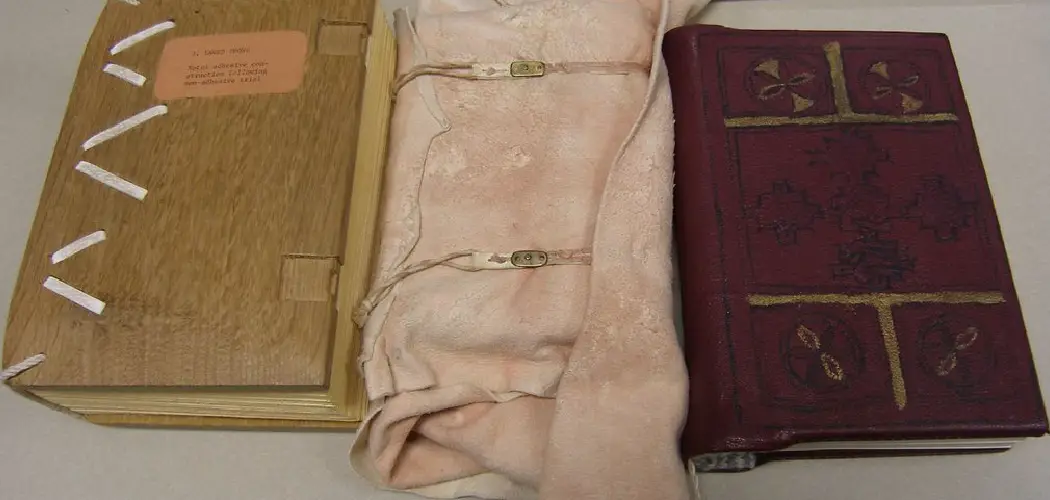Are you tired of using paper towels and microfiber cloths to clean your car? Are you looking for a more efficient and eco-friendly option? Look no further than the chamois leather!
Chamois leather, recognized for its superior drying and polishing qualities, is an essential tool for automotive enthusiasts and professionals alike. Originating from the soft, pliable skin of the chamois—a type of mountain goat—this natural leather offers a non-abrasive, lint-free solution for drying vehicles to a spotless finish.
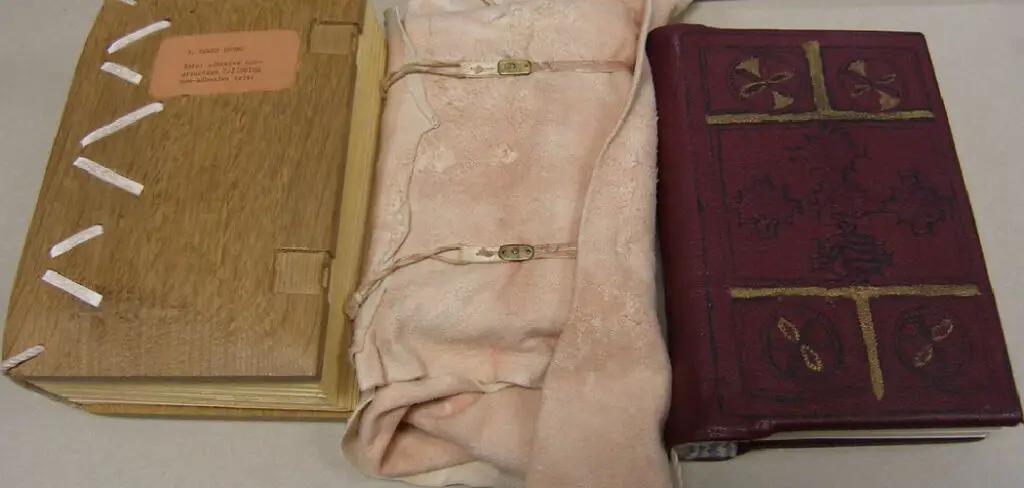
In this guide, we’ll explore the proper techniques for preparing, using, and maintaining chamois leather to achieve a streak-free shine on your car, ensuring that it doesn’t just look good but remains protected from the elements. Whether you’re detailing a classic car or simply caring for your daily driver, understanding how to use a chamois leather is key to preserving the vehicle’s appearance and longevity.
What are the Benefits of Using a Chamois Leather?
Aside from being eco-friendly, chamois leather offers several benefits for car cleaning and detailing:
- Highly Absorbent: Chamois leather can hold up to 6x its weight in water, making it ideal for drying large surfaces like cars.
- Non-abrasive: Unlike some synthetic materials, chamois leather won’t scratch or damage your vehicle’s paint.
- Lint-free: Chamois leather doesn’t leave any lint behind, ensuring a spotless finish every time.
- Durable: With proper care and maintenance, chamois leather can last for years, making it a cost-effective choice in the long run.
- Versatile: In addition to drying, chamois leather can also be used for polishing, removing dust and dirt, and even cleaning windows and mirrors.
- Chemical-free: Chamois leather doesn’t require chemical cleaners, making it a safe and environmentally friendly option for car care.
These benefits make chamois leather an excellent choice for achieving a professional-level clean and shine on your car.
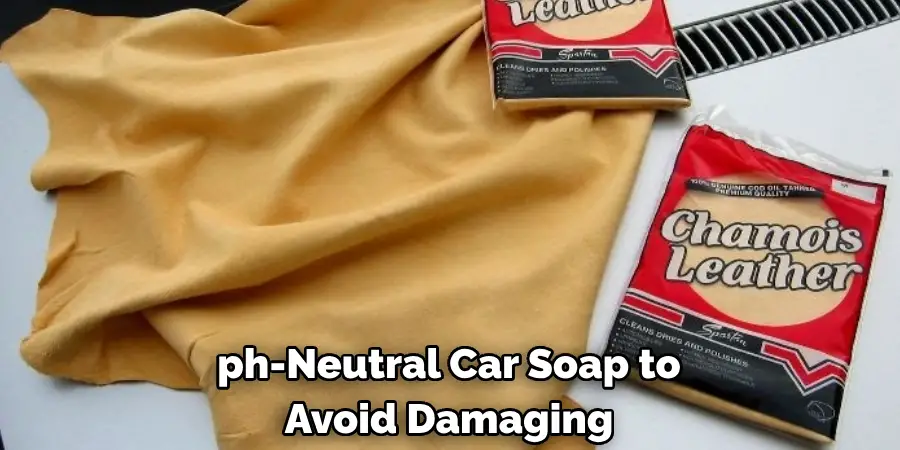
What Will You Need?
Before you begin using your chamois leather, make sure you have the following items on hand:
- Chamois leather: You can purchase chamois leather from any auto parts store or online retailer. Make sure to choose one made from genuine chamois skin.
- Bucket of water: Depending on the size of your vehicle, you may need a large bucket to fill with water for washing and rinsing.
- Car soap: Choose a mild, pH-neutral car soap to avoid damaging your vehicle’s paint.
- Soft cloth: This will be used to gently wipe down the chamois leather before use.
Once you have these items, you’re ready to start using your chamois leather!
10 Easy Steps on How to Use a Chamois Leather
Step 1. Prepare the Bucket:
Fill your bucket with clean, lukewarm water. If your chamois leather is new or has been stored dry, you’ll need to soak it in water to make it soft and pliable before use. Additionally, you can add a small amount of car soap to the water for added cleaning power.
Step 2. Clean Your Car:
Before using the chamois leather, it’s crucial to thoroughly clean your car. Begin by rinsing the car with a hose to remove any loose dirt and grime. Then, gently wash the car’s surface in sections using a soft sponge or cloth and the soapy water from your bucket. Start from the top and work your way down, as the lower sections tend to be the dirtiest.
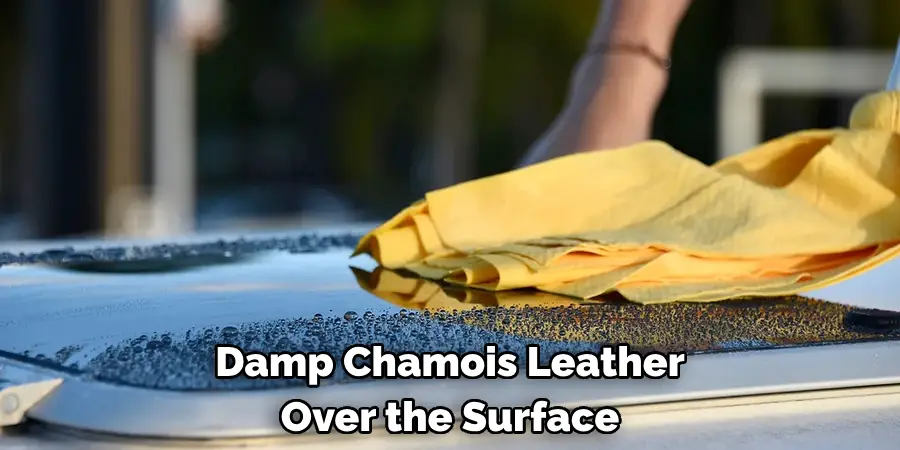
Pay special attention to removing any bird droppings, tree sap, or other substances that can damage the car’s paint if left untreated. After cleaning each section, rinse the soap off with clean water, ensuring no soap residue remains.
Step 3. Wring Out the Chamois Leather:
After soaking your chamois leather in the bucket, take it out and gently wring it to remove excess water.
The chamois should be damp, not soaking wet, to effectively dry your vehicle without leaving water streaks. Properly wringing out your chamois also ensures that it is soft and pliable, making it easier to handle and maneuver over the car’s surfaces.
Step 4. Start Drying with the Chamois Leather:
Begin at the roof of the car and slowly move the damp chamois leather over the surface in a gentle, circular motion. This technique helps to prevent streaking and ensures an even dry.
Make sure to frequently rinse the chamois in clean water to remove any dirt or debris that may have been picked up, and wring it out well each time to maintain its effectiveness. Proceed to dry the car section by section, working your way down to ensure that water doesn’t drip onto already dried areas, which could cause water spots.
Step 5. Address the Car’s Corners and Edges:
After drying the larger surfaces, pay attention to the car’s corners and edges where water tends to accumulate. These areas require a more detailed approach. Fold the chamois leather into a smaller, more manageable size that can fit into these tighter spaces.
Gently dab and swipe along the edges and corners, making sure to absorb all the residual water. This meticulous attention to detail helps prevent rust and ensures that your car dries uniformly without any missed spots.
Step 6. Dry the Windows and Mirrors:
Once you’ve addressed the body of the car, it’s time to focus on the windows and mirrors. The same gentle, circular motion used on the car’s exterior can be applied here. However, ensure that the chamois leather is only lightly damp at this point to avoid leaving streaks on the glass.
If necessary, rinse and wring out the chamois again before proceeding. Drying the windows and mirrors effectively enhances the car’s appearance and ensures clear visibility for the driver.
Step 7. Polish with a Dry Chamois:
After the entire car is dry, use a second, completely dry chamois leather to give the vehicle a final polish. This step will help remove any remaining water spots and give the car a beautiful, streak-free shine.
Gently glide the dry chamois over the car’s surface in the same circular motion, paying special attention to any areas that might have been missed or need extra polishing. This final touch not only enhances the aesthetic appeal of your vehicle but also contributes to the preservation of the paint by removing microscopic water droplets that could damage the surface over time.
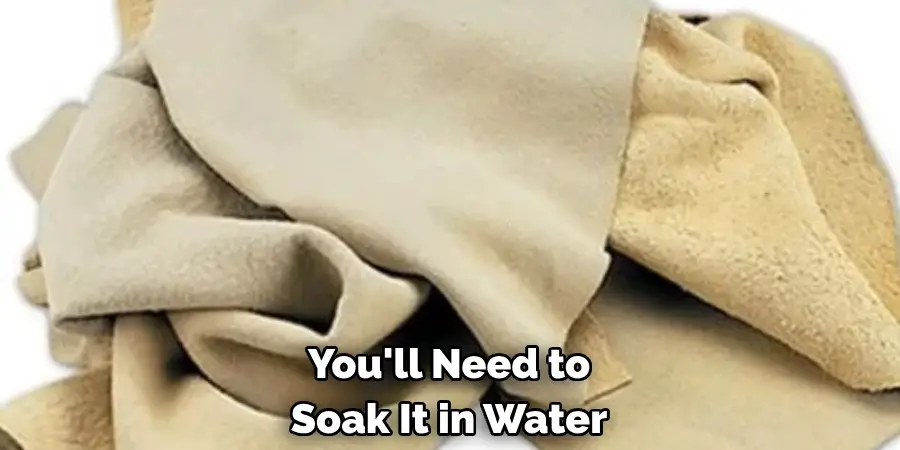
Step 8. Inspect Your Vehicle for Missed Spots:
Even after meticulously following the drying and polishing process, it’s possible to overlook small areas or spots. Take a moment to closely inspect your vehicle in good lighting, looking for any water spots, streaks, or areas that may have been missed. Focus particularly on door handles, side mirrors, and the undersides of the car’s body where water can hide.
If any spots are found, simply dampen your chamois leather slightly and gently go over these areas until the surface is completely uniform and dry. This step ensures that your car looks professionally cleaned and maintains its aesthetic appeal.
Step 9. Care for Your Chamois Leather:
After successfully drying and polishing your vehicle, it’s vital to properly care for your chamois leather to extend its life and maintain its effectiveness. First, rinse the chamois thoroughly with clean, lukewarm water to remove any dirt, soap, or residue.
Then, wring it out gently to ensure it is not soaked but still slightly moist. Store the chamois in a clean, dry place, preferably in a container that allows it to breathe and stay soft. Avoid storing it in direct sunlight or a tightly sealed container, as this can cause the chamois to become dry and brittle. Regular care ensures that your chamois leather remains a reliable tool for keeping your vehicle looking shiny and new.
Step 10. Review and Repeat as Necessary:
Once your vehicle and chamois leather are properly cared for, making this cleaning and drying routine a regular part of your vehicle maintenance protocol is useful. Regular washing and drying keep your car looking visually appealing and protect its paint and finish from the long-term damage caused by dirt, pollutants, and the elements.
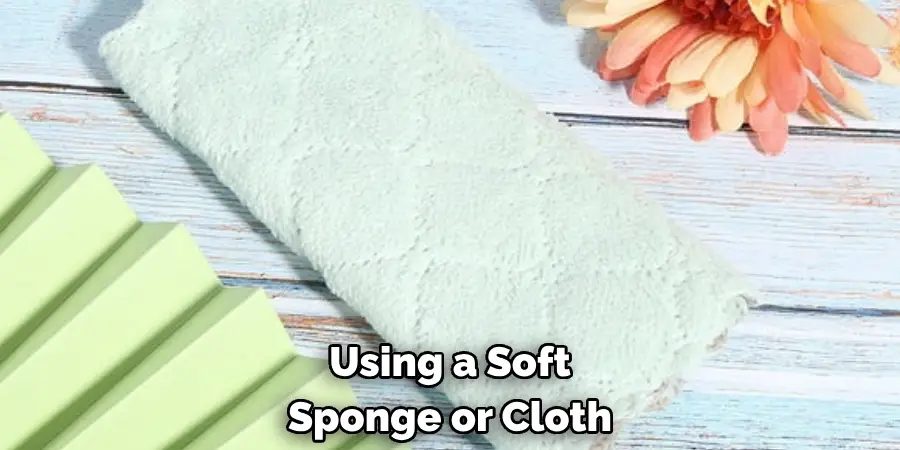
By incorporating these steps into your care routine, you ensure that your vehicle remains in top condition, preserving its value and your enjoyment of it. Remember to inspect your chamois leather before each use for signs of wear and tear, and replace it when necessary to maintain the highest quality of care for your vehicle.
By following these simple and effective steps, you can ensure that your vehicle is thoroughly and efficiently dried without any damage to its paint or finish.
5 Additional Tips and Tricks
- Pre-Use Preparation: Before using your chamois leather for the first time, it’s a good idea to soak it in lukewarm water for a few minutes. This initial soaking helps to soften the material, making it more flexible and easier to handle. After soaking, wring out the excess water, and your chamois is ready for use.
- Avoid Harsh Chemicals: When cleaning your chamois leather, steer clear of harsh detergents or soaps. These can degrade the natural oils in the leather, reducing its lifespan and effectiveness. Instead, use a mild soap or specially formulated chamois cleaner to preserve its condition.
- Rolling Technique for Drying: Instead of stretching or pulling the chamois across your car’s surface, try the rolling technique. Lay the chamois flat on the surface and gently roll it towards you. This method efficiently absorbs water without putting too much pressure on the paint or leaving streaks.
- Partial Drying for Interiors: A slightly damp chamois can be a great tool for cleaning and dusting the interior surfaces of your car, such as the dashboard, console, and door panels. The chamois will pick up dust and light dirt without leaving residue behind, keeping your car’s interior clean and fresh.
- Regular Maintenance of Chamois: After every use, it’s crucial to properly clean, dry, and store your chamois leather. However, even with meticulous care, the chamois may lose its softness and absorbency over time. To rejuvenate it, soak the chamois in a solution of salt water (one tablespoon of salt per liter of water) for a couple of hours, then rinse thoroughly in clean water and allow it to air dry.
With these additional tips and tricks, you can make the most of your chamois leather and ensure that your vehicle stays in top condition with a shiny, water-spot-free finish.
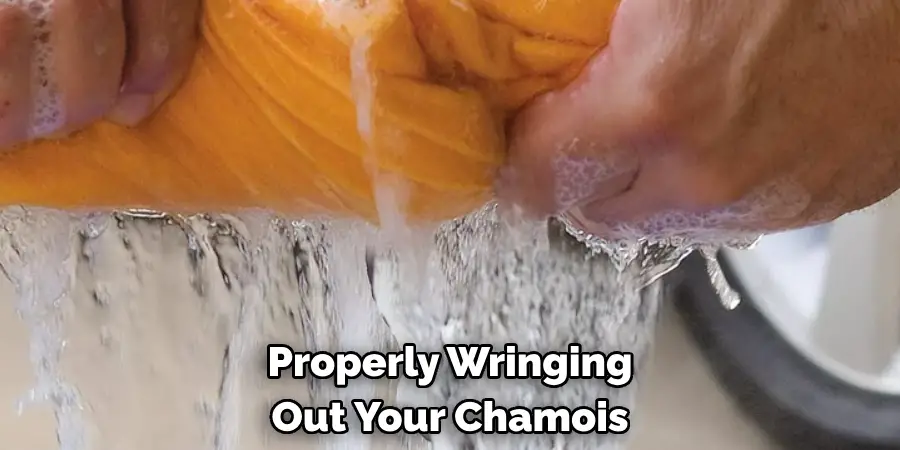
5 Things You Should Avoid When Using a Chamois Leather
- Don’t Use It Dry: Always ensure your chamois leather is slightly damp before using it on your vehicle. A dry chamois can cause scratches and damage to the paintwork by dragging dirt and debris across the surface.
- Avoid Direct Sunlight: Do not leave or use the chamois under direct sunlight. The heat can cause the chamois to dry out too quickly, losing its absorbency and pliability, which can lead to streaks or even damage when applied to the car’s surface.
- Don’t Store It Wet: After using your chamois leather, make sure it’s properly rinsed and slightly dried before storing it. Storing it wet can encourage the growth of mold and mildew, which can compromise its quality and your health.
- Refrain From Using Rough Surfaces: Chamois leathers are designed for smooth surfaces like your vehicle’s exterior. Using them on rough surfaces can tear or severely wear down the leather, reducing its lifespan and effectiveness.
- Do Not Use With Chemicals: Though it might be tempting to pair your chamois with household cleaners for deeper cleaning, harsh chemicals can degrade the natural oils and fibers in the leather, damaging it over time. Stick to using clean water or car-specific cleaning solutions.
By avoiding these common mistakes, you can ensure that your chamois leather remains in top condition and continues to provide a spotless finish for your vehicle.
How Do You Soften Chamois Leather?
Over time and with regular use, chamois leather can become stiff or rough, reducing its effectiveness in drying your vehicle. If your chamois has lost its softness, there are a few methods you can try to rejuvenate it:
- Soak in Saltwater: As mentioned earlier, soaking the chamois in a solution of salt water (one tablespoon of salt per liter of water) for a couple of hours can help soften the fibers and restore their absorbency. Be sure to rinse it thoroughly and allow it to air dry before use.
- Use Conditioner: Just like your hair needs conditioner to stay soft and hydrated, so does your chamois leather. You can either purchase a specialized chamois leather conditioner or use a small amount of hair conditioner to gently massage the leather before rinsing and drying.
- Steam Iron: If your chamois is only slightly stiff, try using a steam iron on a low heat setting to help soften it. Make sure not to keep the iron in one place for too long, as this can damage the leather, and always test on a small area first.
With these methods, you can bring back the softness and pliability of your chamois leather, ensuring that it continues to provide an effective and gentle way to dry your vehicle.

What is Better Than a Chamois?
While chamois leather is a popular and effective option for drying your vehicle, there are some alternatives that you can consider:
- Microfiber Towels: Microfiber towels are designed specifically for car cleaning and detailing and have become a popular alternative to chamois leather. They are super absorbent, leave no streaks, and can be reused multiple times after washing.
- Drying Blowers: Using a drying blower, such as a leaf blower or specialized car dryer, can be an efficient and gentle way to dry your vehicle without the need for any material. However, this method may be less effective in removing all water droplets from hard-to-reach areas.
Ultimately, the best choice for you will depend on your personal preference and your vehicle’s specific needs. With proper care, both chamois leather and microfiber towels can provide excellent results in keeping your car’s exterior clean and spotless. So next time you want to give your car that showroom shine, remember these tips and choose the best method for you!
Does Chamois Leather Scratch?
When used correctly, chamois leather should not scratch your vehicle’s surface. However, if the chamois is dirty or dry, it can trap dirt and debris between its fibers, which can cause scratches when applied to the car’s paintwork. It’s crucial to regularly clean and maintain your chamois to prevent this from happening. Additionally, using a smooth, overlapping motion when drying your car can help prevent any accidental scratches. So always keep your chamois clean and slightly damp for a smooth and scratch-free finish!
After all, the goal is to have a sparkling clean car and protect its paint and finish. With proper care and maintenance of your chamois leather, you can achieve both and keep your vehicle looking its best for years to come.
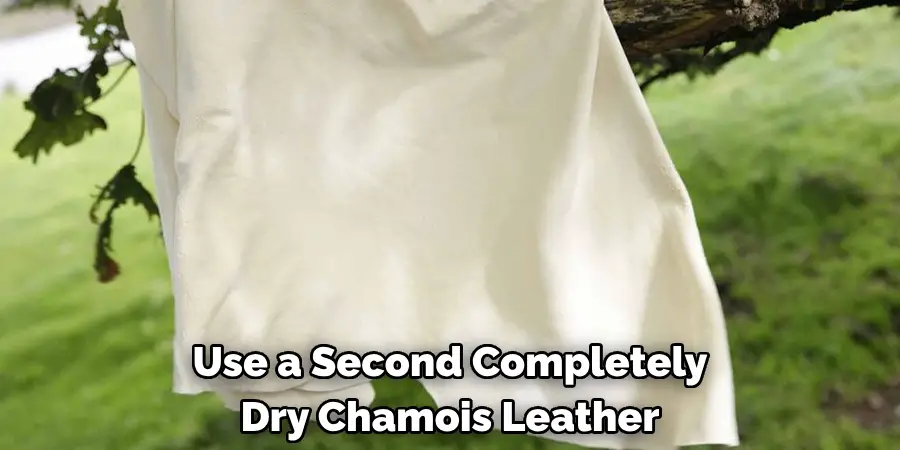
Conclusion
In conclusion, how to use a chamois leather for drying your vehicle can significantly enhance the appearance of your car, providing it with a streak-free, spotless finish. Whether you’re using it to dry the exterior after a wash, clean and dust the interior, or maintain its shine between washes, understanding the correct techniques and practices is crucial.
By following the tips outlined in this guide, such as keeping the chamois slightly damp, avoiding direct sunlight, and steering clear of rough surfaces or harsh chemicals, you can maximize the lifespan and effectiveness of your chamois leather. Additionally, knowing how to properly soften and condition your chamois will ensure it remains a reliable tool in your car care arsenal.
While there are alternatives available, like microfiber towels and drying blowers, the choice ultimately depends on your specific needs and preferences. With proper care and usage, a chamois leather can be an invaluable asset for keeping your vehicle in pristine condition.

